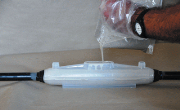 Technical manager at Prysmian Cables & Systems, Jonathan Rawlinson, discusses the impact that recent changes to EU chemical legislation has on cable jointing resins and anyone who uses them
Technical manager at Prysmian Cables & Systems, Jonathan Rawlinson, discusses the impact that recent changes to EU chemical legislation has on cable jointing resins and anyone who uses them
During the course of work with electrical cables there will eventually be a need to join two together. The most common way of doing this is with a resin product, of which there are many on the market. However, as of December 1st last year, some of these products have undergone a change to their hazardous labelling. Therefore, it is important to be aware of why these changes have come about and what it means for health and safety.
Changes to legislation
Traditional technology associated with most cable jointing resins uses polyurethane. A major chemical component in this material is an isocyanate known as MDI. Concerns have existed for years that this chemical ingredient presents a health and safety risk to those who work with products containing it.
Attempts have been made at a European level over the past ten years to have MDI re-classified as a carcinogen (a substance that is an agent directly involved in causing cancer). The EU, via the European Chemical Agency (ECHA), has the responsibility of doing this and also implementing a new globally harmonised labelling system (CLP). Under this new system, MDI is now classified as carcinogen Category 2 – ‘suspected of causing cancer’.
From December 1st 2010, any cable joint resin product containing MDI must display this new labelling. It carries the new ‘cancer’ warning and also warns of the other risks associated with MDI already well known. These include being an irritant to skin and eyes as well as being a sensitiser (a chemical which may lead to the development of allergic reactions after repeated exposure).
 History
History
For some time now firms have been working on resin solutions that present no health and safety risk. Indeed, as far back as 1998, a UK power utility firm approached Prysmian with concerns that resin joint kits containing MDI could have adverse affects on staff.
The idea was to create a non-hazardous MDI-free system for jointing of electrical cables that also complied with the requirements of the European standard, BS EN 50393 and the Energy Networks Association, Engineering Recommendation C81 type test.
Some have suggested that HDI is a suitable alternative to MDI as it is not affected by the changes to legislation. However, there are disadvantages associated with this chemical.
Firstly, the raw material cost of HDI is substantially higher than that of MDI. This would result in a prohibitively high cost for the resulting resin. In addition, HDI-based resins have little service history in buried cable jointing applications and are also known sensitisers.
Perhaps of even more importance with this chemical is that it could be re-classified in future in much the same way MDI has been. So, using HDI-based resins now could result in the same issues currently being faced by those containing MDI
Answers
Prysmian developed a solution to this problem back in 1999 in the form of JEM (joint encapsulation material). Independent tests showed the product to be non-irritating to eyes or skin and non-sensitising.
This means JEM resin kits have to carry none of the hazard labelling currently required by those containing MDI. JEM resins are also non-flammable and therefore do not require any special storage or transport. During development JEM resin underwent large scale field trials that proved the product performs as intended. As of December 1st last year all Prysmian resin jointing kits are JEM only, containing no harmful MDI.
It must be said that there is no requirement to change your existing working practice when handling resins containing MDI (of course current levels of industrial hygiene and PPE should be maintained).
This is because the listing of MDI as a carcinogen Category 2 was the result of testing with it in aerosol form. With cable jointing resins coming in liquid form, it is true that the risk of cancer occurring cannot be truly quantified, even if the material is swallowed or vapours inhaled.
Nevertheless, that is not to say the material cannot cause irritation and allergic reactions that then become permanent. The most common result of inhaling MDI vapour is still respiratory sensitisation leading to occupational asthma. It would be sensible to make sure that any risk of this happening to staff or customers, no matter how small, is eliminated.






